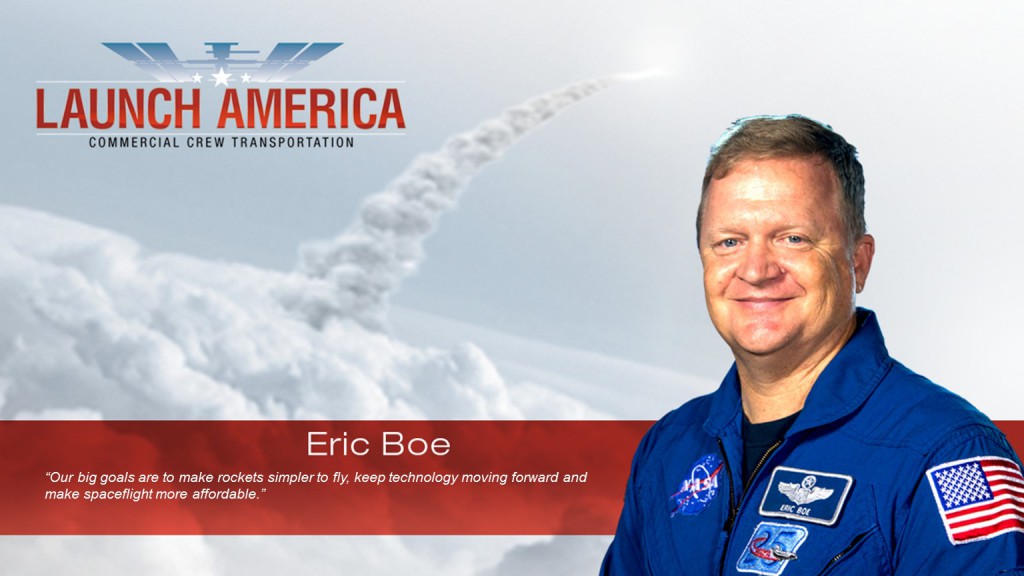NASA’s Commercial Crew Program astronauts had the opportunity to see the Crew Access Arm and White Room under construction near Kennedy Space Center in Florida last week. Read more of what they had to say about the progress made thus far, at http://go.nasa.gov/1QPRz54.
Author: Stephanie Martin
Seeking Sky Walkers
Have you ever wanted to explore to a galaxy far, far away? Is the Force strong in you? NASA seeks sky walkers to join the astronaut alliance. Learn more, at www.nasa.gov/astronauts.
Young Explorers’ Creativity Needed
NASA’s Commercial Crew Program wants you to 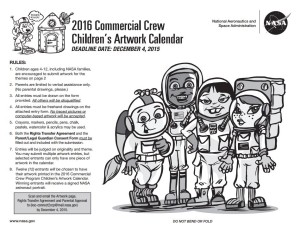 help draw our future in space exploration! We are looking for your artistic vision for this year’s 12 categories, ranging from rockets to experiments in space, and Florida Space Coast launches to NASA’s journey to Mars. Can you help?
help draw our future in space exploration! We are looking for your artistic vision for this year’s 12 categories, ranging from rockets to experiments in space, and Florida Space Coast launches to NASA’s journey to Mars. Can you help?
We are producing our 2016 calendar in a few weeks and we need your drawings to fill its pages. Children ages 4-12, regardless of NASA affiliation, can submit their artwork. Selections may be featured on the Commercial Crew website!
The deadline for submissions is Dec. 4 at noon EST. We’re looking for the best artwork related to the following themes:
- Astronauts: NASA’s astronauts have many skills and experiences that make them perfect for the variety of jobs they do both in space and on the ground. During their careers, astronauts could pilot a spacecraft, run experiments on the International Space Station, train new astronauts and even help guide other astronauts through challenging work in space from Earth. What job would you want to do if you were an astronaut?
- Rockets: The commercial crew rockets that will carry astronauts to the International Space Station will be smaller than NASA’s Space Launch System rocket, as well as the agency’s previous Saturn V and space shuttle systems. Their missions are different, so their designs are different. Think of it like riding your bike to see your next door neighbor. You would ride a bike to see your neighbor, but you would take a bus to travel across the country. Let’s see your best rocket drawing!
- Spacecraft: Spacecraft carrying astronauts are stacked on top of rockets before launching them into space. Orion is the first spacecraft since Apollo that NASA has built with an eye on distant worlds. NASA’s Space Launch System rocket and Orion spacecraft, now in development, will enable humans to reach asteroids beyond lunar orbit, Mars and other potential destinations. At the same time, the space agency is working with commercial companies to launch astronauts to the space station and return them home safely. The commercial crew spacecraft astronauts will fly to the International Space Station—the SpaceX Crew Dragon and Boeing CST-100 Starliner—will be lightweight, but tough enough to withstand meteorites. What would your spacecraft look like?
- Spacecraft Interior: Every spacecraft’s interior has been unique and advanced for its time. In the past, NASA’s spaceships, which also are called spacecraft, had thousands of knobs and dials. Today’s spacecraft could feature tablet-like technology, parts like engines and seats that are printed on a machine called a 3-D printer, Wi-Fi and much more. What would you want inside your spacecraft?
- Spacesuits: An astronaut’s spacesuit is like his or her own personal spacecraft. Spacesuits keep astronauts safe by providing breathable air and keeping them warm and cool. Spacesuits also are pressurized like the inside of a flying airplane so that the astronauts are safe in space. Spacesuits allow the astronauts to be in constant communication with doctors and medical professionals who track their health here on the ground. Design your own spacesuit . . . think about ease of motion and what tools you’d need a suit to have outside the spacecraft.
- Florida Space Coast Launches: The rumble . . . the glow . . . the excitement! Every time NASA has launched people off the surface of Earth and into space, it has been from Florida’s Space Coast. In the next couple years, we will see commercial crew spacecraft rockets glow orange and make huge plumes of smoke as astronauts launch to the International Space Station from Florida. In the 2030s, we also will see astronauts launching from Florida’s Kennedy Space Center as they begin their journey to Mars. Draw who you plan to watch launches with… family, friends, perhaps Florida’s abundant wildlife.
- International Space Station: Look up! The International Space Station is orbiting about 250 miles above the surface of Earth, 24 hours a day, seven days a week, 365 days a year at 17,500 miles every hour. Aboard, astronauts conduct very important experiments that help us here on Earth. They also are learning how to live for long periods of time in space, which will help future astronauts on their journey to Mars. Commercial crew spacecraft will carry up to four crew members to the station so that even more experiments can be done! Show us your best drawing of the space station. Remember it’s the size of a football field!
- Experiments: Every day, astronauts perform experiments aboard the International Space Station, which is commercial crew’s destination in space. Those experiments make our lives better here on Earth, help us understand more about our own planet and space, and prepare us for missions to Mars. What kind of experiments would you do in space?
- Space Safety: Commercial crew spacecraft that will fly astronauts to the International Space Station are designed to keep astronauts safe throughout their entire mission. The spacecraft are designed to separate from a rocket, as well as safely and quickly carry the station’s crew back to Earth in an emergency. How would you keep a crew safe in space?
- Landing: Spacecraft landings are quite impressive. After flying through space and re-entering the atmosphere at 17,500 miles per hour, spacecraft have to land smoothly to protect the astronauts and science experiments they carry. Commercial crew engineers are looking at different ways to land with parachutes and airbags, fly to a runway like an airplane, or land using only rocket engines. Show us what you think a spacecraft landing looks like.
- NASA’s Journey to Mars: NASA’s Space Launch System rocket will be the most powerful rocket ever built, designed to take astronauts to deep space, eventually even to Mars. At the same time, the experiments that astronauts are doing on the International Space Station help NASA understand what future astronauts will need to live on Mars. What do you think it will be like to live on Mars?
- You Could Fly To Space: Right now, only astronauts can fly to space, but soon NASA astronauts won’t be the only people flying into space in new commercial crew spacecraft. American companies will own their own spacecraft and rockets to carry other people into space. People will be able to buy tickets to take a short trip into space and come right back
to Earth. . . will you be one of them? Draw what you would do if you could fly to space.
And here’s all you need to get started: CCP Artwork and Consent Form
Recap of Today’s Live Chat with Behnken and Williams
Don’t worry if you missed this afternoon’s NASA Live Chat with Commercial Crew astronauts Bob Behnken and Sunita “Suni” Williams. You can read a recap from this afternoon’s Live Chat, at http://go.nasa.gov/1NRgSEb.
You also can watch the video replay below.
Commercial Crew Astronauts Answer Questions Live on NASA TV
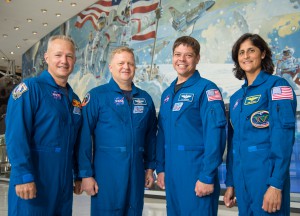 NASA’s Commercial Crew Program has contracted with American aerospace industry partners Boeing and SpaceX to return the capability to launch astronauts to the International Space Station (ISS) from American soil. This exciting program allows NASA to focus on deep-space exploration, while stimulating a growing spaceflight economy to low-Earth orbit.
NASA’s Commercial Crew Program has contracted with American aerospace industry partners Boeing and SpaceX to return the capability to launch astronauts to the International Space Station (ISS) from American soil. This exciting program allows NASA to focus on deep-space exploration, while stimulating a growing spaceflight economy to low-Earth orbit.
Now is your chance to ask Bob Behnken and Sunita “Suni” Williams about their selection to be among the first astronauts to train for commercial crew test flights! They are three months into their commercial crew assignments, and will answers questions live on NASA TV on Monday at 12:30 p.m. EDT. To participate, submit your questions in the comments below, tweet us @Commercial_Crew with #askNASA or post to our Facebook page with #askNASA. We’ll take questions in advance and live during the show.
A new generation of human-rated American spacecraft is in development under the Commercial Crew Program that will operate safe, reliable and cost-effective transportation to the space station. Instead of NASA designing and operating a new spacecraft, rocket and all the ground support equipment required for successful human space transportation system, the agency offered the aerospace industry a chance to apply its own innovations while still meeting NASA’s requirements.
Boeing’s CST-100 Starliner spacecraft will launch on a United Launch Alliance Atlas V, and SpaceX’s Crew Dragon spacecraft will launch on the company’s Falcon 9 rocket. These systems will send astronauts to the station where they can perform more of the research that is making life better on Earth, and preparing future astronauts for missions to an asteroid, Mars and beyond.
We hope you join us Monday to find out if Bob and Suni answer your question.
SpaceX Unveils Crew Dragon Interior
From OPF to C3PF: A New Facility for a New Era
The third of NASA’s Orbiter Processing Facilities built to protect the space shuttle fleet as engineers outfitted them for their next flights is nearing the end of its renovation into a factory for a new generation of spacecraft. The transformation required extensive work, starting with the removal of the tons of steel and aluminum work stands and platforms custom-built for shuttle servicing as seen in the video below. Space Florida, in coordination with Kennedy and Boeing, removes obsolete infrastructure so Boeing could modernize the facility.
Now called the Commercial Crew and Cargo Processing Facility, or C3PF, the high bay and adjoining work areas will be the production, assembly and processing home for Boeing’s Commercial Space Transportation (CST)-100 spacecraft. Developed in partnership with NASA’s Commercial Crew Program, the CST-100 is designed to launch on a United Launch Alliance Atlas V rocket to take astronauts to the International Space Station so they can add to the important science being performed every day in orbit.
C3PF Makeover
 You can see Florida taking shape on the front of Boeing’s Commercial Crew and Cargo Processing Facility, better known as C3PF, at NASA’s Kennedy Space Center. The 78,000 foot facility will be the production and processing home of Boeing’s Crew Space Transportation (CST)-100 spacecraft.
You can see Florida taking shape on the front of Boeing’s Commercial Crew and Cargo Processing Facility, better known as C3PF, at NASA’s Kennedy Space Center. The 78,000 foot facility will be the production and processing home of Boeing’s Crew Space Transportation (CST)-100 spacecraft.
What do you expect Boeing will add to the wrap next?
IDA-2 Goes Horizontal for Pre-Launch Testing
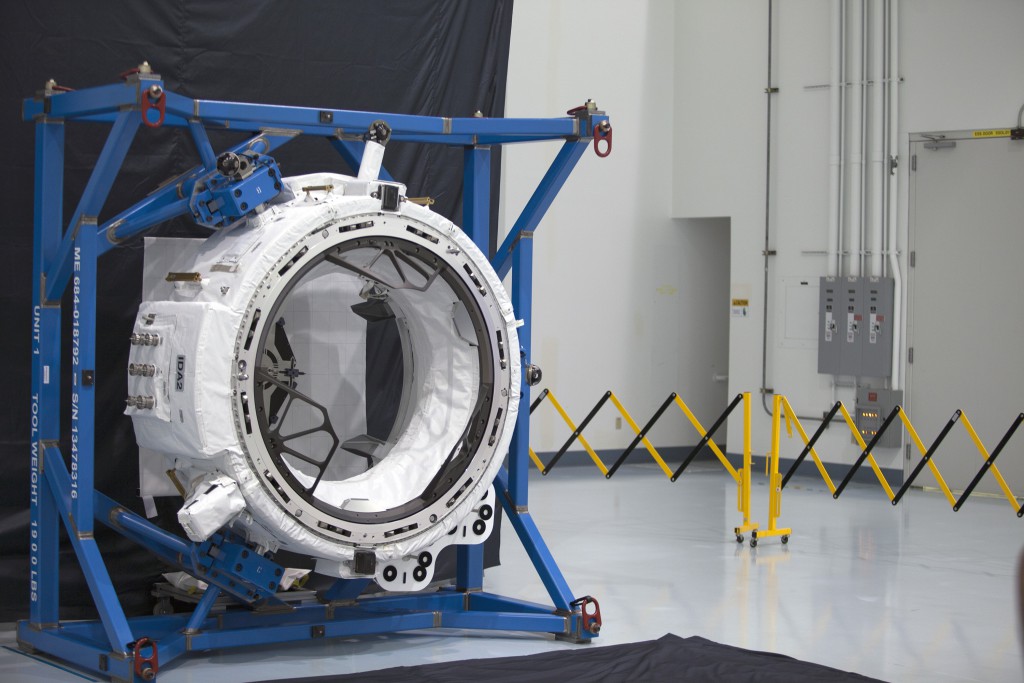 Engineers in the Space Station Processing Facility at NASA’s Kennedy Space Center in Florida recently tested the mechanisms that will connect future commercial crew spacecraft with the second International Docking Adapter. IDA-2, as it’s called, will be taken to the space station on a future cargo resupply mission. It will be one of two connection points for commercial crew spacecraft visiting the orbiting laboratory. The systems and targets for IDA-2 are set to be put through extensive tests with both Boeing’s CST-100 and SpaceX’s Crew Dragon before the adapter is loaded for launch.
Engineers in the Space Station Processing Facility at NASA’s Kennedy Space Center in Florida recently tested the mechanisms that will connect future commercial crew spacecraft with the second International Docking Adapter. IDA-2, as it’s called, will be taken to the space station on a future cargo resupply mission. It will be one of two connection points for commercial crew spacecraft visiting the orbiting laboratory. The systems and targets for IDA-2 are set to be put through extensive tests with both Boeing’s CST-100 and SpaceX’s Crew Dragon before the adapter is loaded for launch.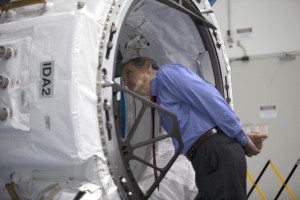
“We set IDA-2 up horizontally for the alignment checks with the CST-100 to more closely mirror how the two would connect in space,” said Steve Bigos, project manager for orbital replacement unit processing at Kennedy. “There is a lot of new technology, so it’s very interesting.”
The targets are much more sophisticated than previous docking systems and include lasers and sensors that allow the station and spacecraft to autonomously communicate distance cues and enable alignment and connection. Think of it as a car that can park itself.







